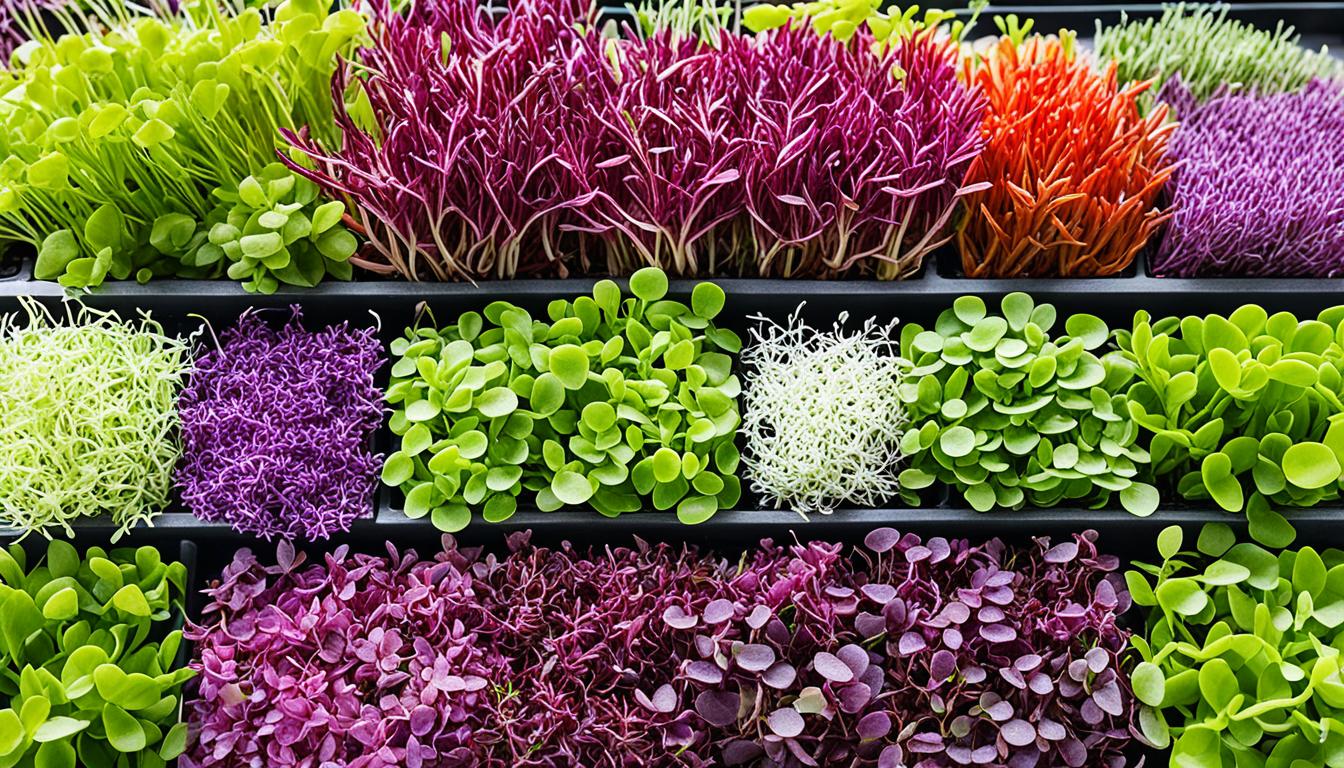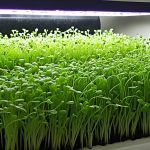Embark on a journey through the vibrant world of microgreens for health, where petite plants pack a powerful punch of vitamins and minerals. These nutrient-rich microgreens are not just a garnish on your plate, but a significant boost to your wellness routine. As we explore the top 10 microgreens, each with its own impressive profile, you’ll uncover the secrets to making these tiny superfoods a big part of your nutrition.
For both seasoned gardeners and newcomers alike, our list focuses on the best microgreens to grow, ensuring that regardless of space or experience, you can access the freshest and most nourishing greens right from the comfort of your own home. So, let’s delve into the lush greenery of health that awaits!
Introduction to Microgreens and Their Nutritional Significance
As more individuals seek to enhance their diets with nutrient-packed foods, microgreens have emerged at the forefront of health trends. These tiny greens are lauded for their dense concentrations of vitamins and minerals and are steadily climbing the popularity ladder for their wide-ranging health benefits. Unlike full-sized vegetables, which require more space and time to cultivate, microgreens offer the ease of growing microgreens at home, delivering a verdant splash of nutrition straight from your windowsill to your plate.
What Makes Microgreens a Superfood?
Microgreens aren’t merely a garnish; they are a superfood in their own right. The term superfood is often ascribed to foods with high nutrient density, and microgreens fit the bill perfectly. They contain elevated levels of vitamins, minerals, and antioxidants when compared to their mature counterparts. The benefits of microgreens stem from their remarkable ability to potentially reduce the risk of various chronic diseases, support a healthy immune system, and contribute to a balanced diet.
Distinguishing Microgreens from Sprouts
Although often mistaken for sprouts, microgreens possess distinct characteristics. Unlike sprouts, which are germinated seeds that are eaten root, seed, and shoot, microgreens are the young seedlings of edible vegetables and herbs harvested just after the first true leaves have developed. They require soil or a soil substitute for growth, differentiating them further from sprouts, which thrive in water. This vital growth process contributes to the microgreens’ nutritional wealth and has been a pivotal factor in their ascent in the popular types of microgreens consumed for health.
The Rise of Microgreens in Health Trends
The booming interest in microgreens is a testament to the shifting paradigm towards whole foods and convenient health solutions. They’ve found their way into the hearts and meals of health connoisseurs and culinary professionals alike. As an added perk, they’re remarkably versatile, elevating the nutritional value of countless dishes without overwhelming flavors. With the simplicity of growing microgreens at home, they represent a bridge between accessible nutrition and gourmet dining, rendering them staples for those who champion a healthy lifestyle.
Exploring the Nutrient Profiles of Popular Microgreen Varieties
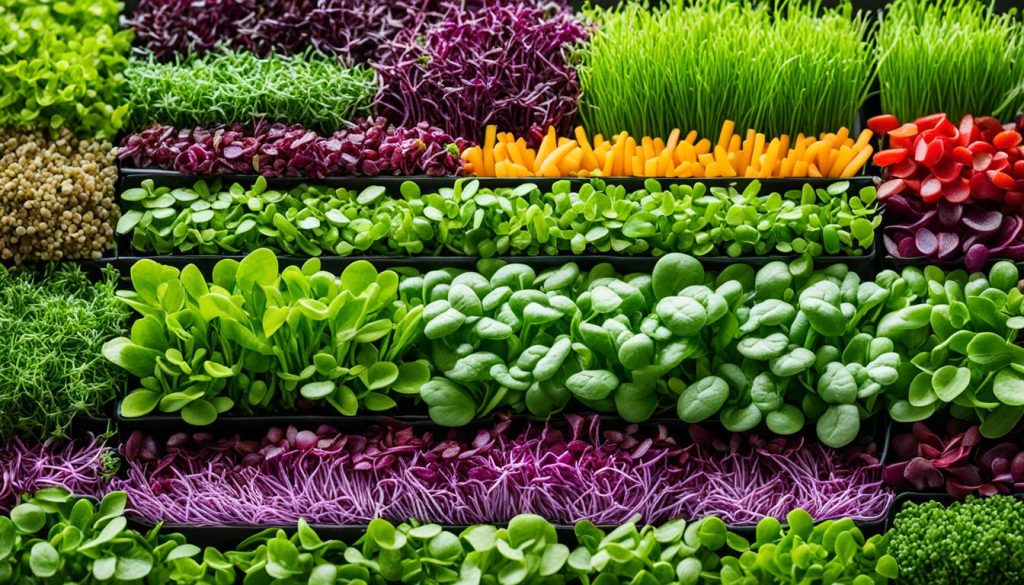
The world of microgreens is not only diverse in flavors and textures but also in the nutritional benefits they offer. Each variety of these miniature greens brings forth a unique blend of vitamins and minerals, contributing to the vast array of microgreens nutritional value. Savvy eaters and health enthusiasts delve into the colorful spectrum of microgreen varieties to enhance their meals with nature’s concentrated sources of nutrients.
Take, for instance, cilantro microgreens, a favorite for their distinct, zesty flavor. Beyond their culinary appeal, they’re recognized for high levels of vitamin C, an essential antioxidant for immune system support, and skin health. Green daikon radish microgreens are not far behind, offering a peppery taste and boasting a wealth of vitamins E and K, vital for bone health and blood clotting.
Another champion in the microgreens category is red cabbage, with its vibrant hue hinting at its rich nutrient content. It stands out for the microgreens health benefits it provides, especially due to the high content of vitamin C, along with vitamins K and E. These microgreens are not just a pleasing addition to your palette but also act as functional foods aiming to boost your overall well-being.
Understanding what each microgreen variety offers enables individuals to make informed decisions about their diet. Whether you’re looking to strengthen your immune system, enhance bone density, or just add a burst of flavor to your food, the inclusion of various microgreens can help achieve those dietary goals. Indubitably, the distinct microgreens health benefits solidify their status as a powerhouse addition to modern nutrition.
Top 10 Microgreens for Optimal Health
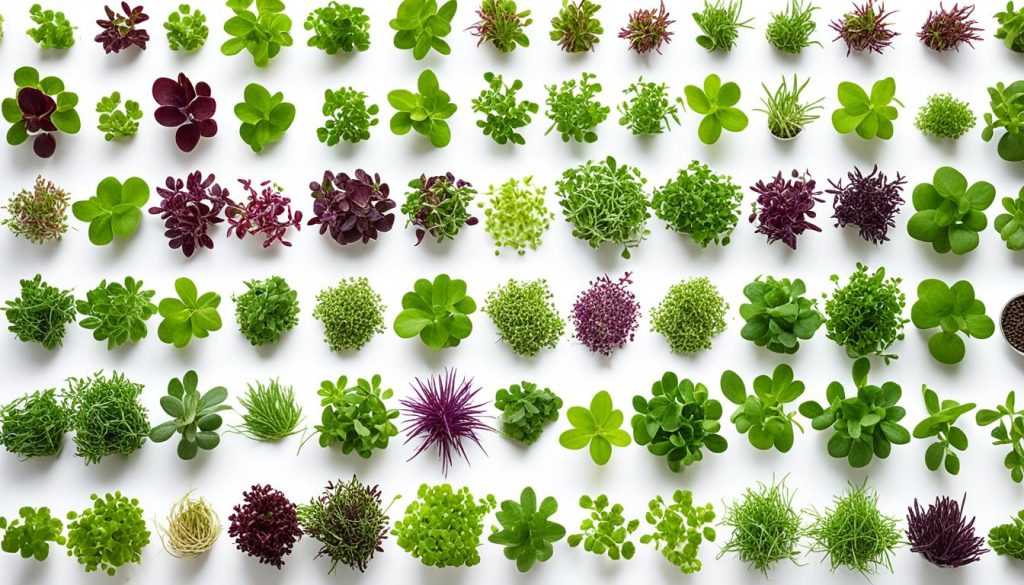
Discovering the ideal sources of nutrition to enhance well-being is a constant journey, and among the edible treasures of nature, microgreens for health are undeniable gems. In the quest for vitality and wellness, we’ve unearthed the top 10 microgreens that stand out for their remarkable nutritional profiles. These selections are not only acclaimed for their health benefits but also for being the best microgreens to grow, whether you’re a culinary aficionado or a novice green thumb looking to infuse your diet with vibrant nutrients.
Powerhouse of Vitamins: Cilantro, Radish, and Red Cabbage
In the illustrious lineup of nutrient-rich microgreens, cilantro, radish, and red cabbage emerge as leaders in vitamin content. These vibrant microgreens are not merely trending in the health community; they play an essential role in fortifying the body with an abundance of vitamins. Cilantro microgreens, for instance, are celebrated for their impressive vitamin C levels, which are essential for immune health and skin vitality. Radish microgreens, with their zesty punch, are equally lauded for their concentrations of vitamins E and K, pivotal for maintaining bone health and ensuring proper blood clotting.
Moving on to the visually stunning red cabbage microgreens, these delicacies offer more than just a splash of color to dishes. They are recognized for their abundant vitamin C content, alongside ample doses of vitamins K and E, making them ideal for those striving to enhance their health through diet. These top 10 microgreens excel not only in flavor but also in their nutritional prowesses, such as aiding in dietary fiber intake, which is crucial for digestive health.
Antioxidant-Rich Choices: Arugula, Sunflower, and Pea Shoots
As we continue to traverse the realm of microgreens, arugula, sunflower, and pea shoots stand out as antioxidant-powered choices. These microgreens represent a confluence of taste and health, serving as both a treat to the palate and a boon to the body. The peppery notes of arugula microgreens are complemented by their potential to fight oxidative stress, a key contributor to numerous chronic diseases.
Sunflower microgreens, on the other hand, are not just a crunchy delight; they are treasure troves of vitamins A, B, D, and E and are known to contribute to the regulation of hormones and lowering of blood cholesterol. Pea shoots are equally impactful, boasting a gentle flavor and a composition rich in antioxidants that support overall health and bone development. These microgreens are a testament to the diversity and versatility of the best microgreens to grow, enhancing meals with a nutritional boost that caters to a range of culinary applications.
The Benefits of Incorporating Microgreens into Your Diet
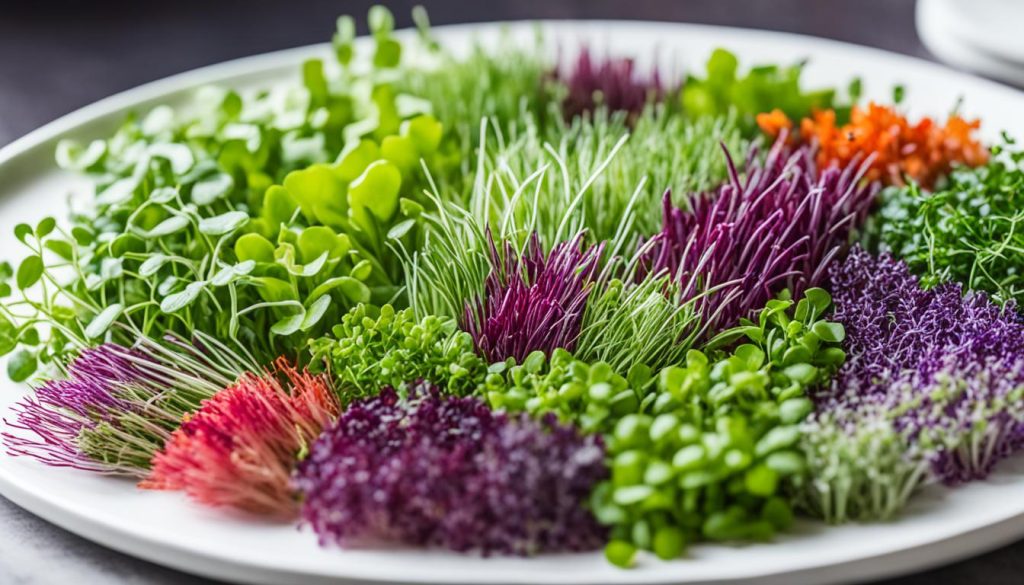
Unlocking a treasure trove of microgreens health benefits, these minuscule but mighty greens are revolutionizing the way we think about our daily vegetable intake. The straightforward addition of microgreens into your diet is a power move for your health, offering more than just a splash of color on your plate. Beyond their visual appeal, microgreens provide an arsenal of vitamins and minerals that drive health promotion through microgreens.
It’s not only the high nutrient content that makes microgreens such a valuable food source; their role in combatting oxidative stress adds another layer to the microgreens dietary inclusion. This is incredibly pertinent, as oxidative stress is implicated in the development of chronic ailments like cancer, diabetes, and heart disease. By weaving microgreens into your meals, you’re taking a proactive stance against these pervasive health issues.
Furthermore, the petite nature of microgreens belies their nutritional potency. They emerge as an effortless and economical choice for enhancing nutrient consumption, which in turn, bolsters your overall health and wellbeing. With microgreens, you’re not only indulging in a kaleidoscope of flavors but also equipping your body with the necessary tools for optimal function.
Integrating microgreens into various dishes is as easy as it is beneficial. From topping off your favorite soups to energizing your morning smoothies, the potential for microgreens dietary inclusion is vast and versatile. In this small package lies a giant leap toward health promotion through microgreens, making them an essential component of a health-conscious lifestyle.
Thus, when we deliberate on the benefits of incorporating microgreens into our diet, we are not merely discussing a trend. We are embracing a powerful, palatable, and practical approach to fortifying our bodies against the stressors of modern life. Whether you are a gourmet chef, a bustling home cook, or just beginning your journey towards better health, microgreens stand as a delicious ally in your culinary adventures.
How to Select and Store Microgreens for Maximum Nutrition
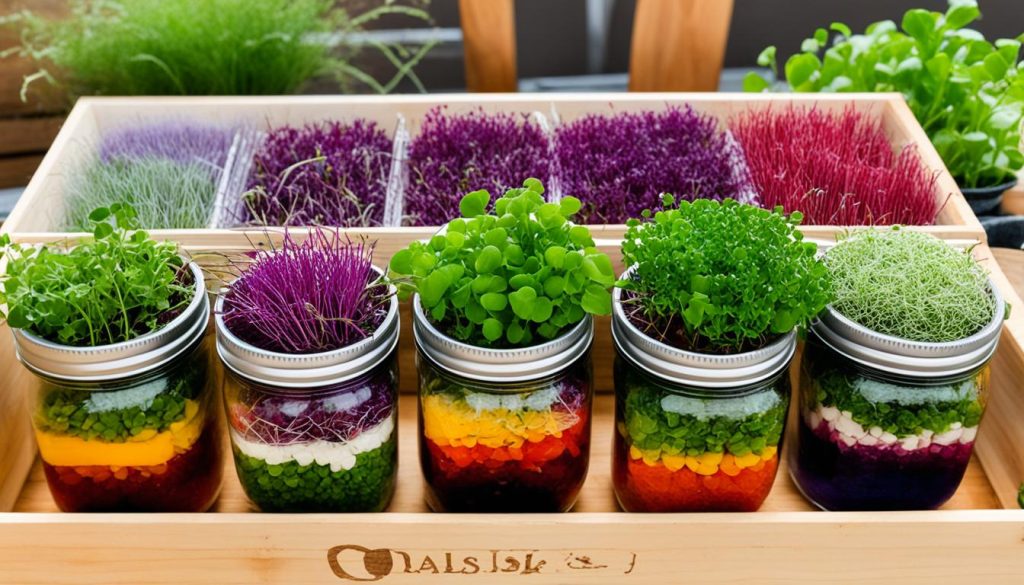
When selecting microgreens, the key is to look for signs of peak freshness to ensure you’re getting the most potent nutrient levels from these leafy gems. Whether you’re browsing the farmers’ market or picking from your own kitchen garden, identifying the freshest offerings is straightforward. Look for microgreens with bright, vivid colors and crisp, upright leaves—a telltale sign of their nutrient-rich vitality and freshness.
Choosing the Freshest Microgreens
The vibrancy of microgreens is your first clue to their freshness. Not only does a lively hue mean they are ripe for the picking, but it also indicates that they’re packed with the vitamins and minerals essential for good health. When handpicking your greens, gently feel the texture. The leaves should be firm and springy to the touch, not wilted or slimy, which can signify they’ve passed their nutritious peak. By selecting microgreens carefully, you can boost the value of your culinary creations while maximizing their health benefits.
Storage Tips to Preserve Nutrients
Once you’ve selected the freshest microgreens, proper storage is paramount in preserving microgreen nutrients. To maintain their vitality, store your greens in breathable containers that maintain humidity without letting moisture accumulate. Keeping them in a cool environment, like the refrigerator, is essential to slow down nutrient degradation. Remember, the way you store your microgreens can significantly impact their nutritional punch and shelf life, helping you savor their benefits for as long as possible.
Growing Microgreens at Home: A Starter Guide
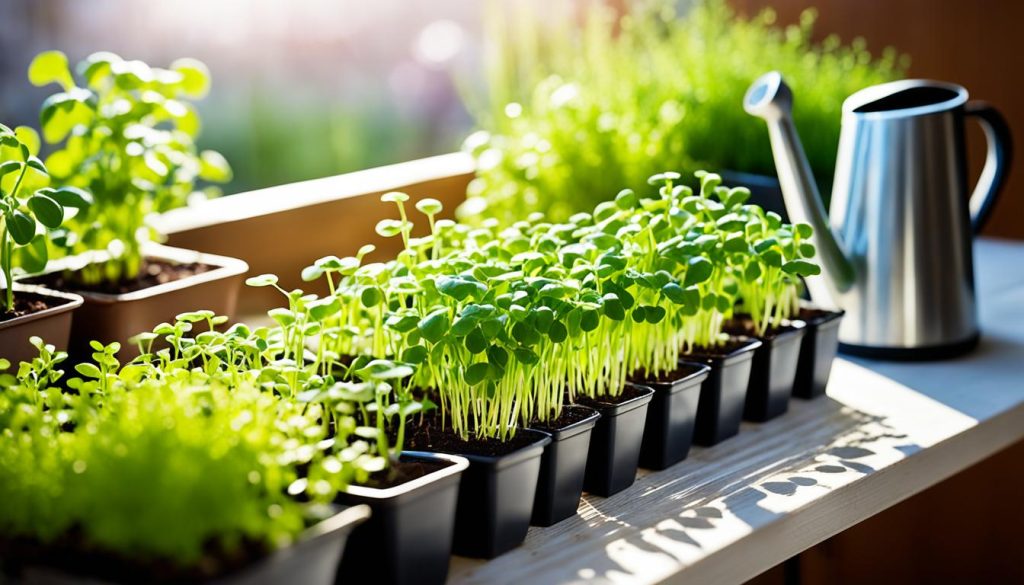
Embarking on the path of growing microgreens at home is an adventure that brings both delight to your taste buds and a boost to your health. It’s a gardening trend that continues to gain momentum, as more people discover the ease with which these tiny nutritional dynamos can be cultivated in just about any corner of their living space. Whether you have a sprawling garden or a modest windowsill, microgreen growing kits offer a straightforward gateway to harvesting your own fresh greens.
For beginners, the allure of microgreens lies in their minimal space requirements and short growth cycles—often as brief as one to three weeks. But don’t let their diminutive size fool you; these greens pack a substantial nutritional punch. The process of how to grow microgreens is not only accessible but also immensely gratifying. Starting from selecting the best seeds to the final harvest, each step ushers in a sense of accomplishment intertwined with the promise of health benefits.
To commence your green thumb journey, high-quality seeds are paramount. Opt for organic, non-GMO varieties from reputable suppliers to ensure the best flavor and nutrient content. Many microgreen enthusiasts prefer soil-less methods, like hydroponic systems, for their cleanliness and efficiency, while others swear by the traditional feel of soil-based cultivation. Regardless of your choice, what’s vital is understanding the importance of spacing seeds properly and mastering the art of strategic watering, ensuring each tiny plant has sufficient room and moisture to thrive.
But what truly simplifies the process are the various microgreen growing kits available on the market. These kits often come with everything you need: a selection of seeds, growing medium, and instructions tailored to even the most inexperienced gardeners. With these kits, you can bypass the trial and error and jump straight into enjoying lush, vibrant microgreens at your fingertips.
Remember, the journey of growing microgreens at home is not just about the destination of a successful harvest. It’s a journey teeming with simplicity, joy, and the gratification of enhancing your meals with home-grown nutrition. So take the first step today, and soon you’ll witness the promising sprouts of health burgeoning from your very own green space.
Delicious and Nutritious: Creative Ways to Use Microgreens in Meals

Microgreens have burst onto the culinary scene, not only for their vibrant color and intense flavor but for their health benefits too. These tiny titans of taste are making big waves in the world of microgreen recipes, offering innovative and nutritious twists to classic dishes. With their versatility, microgreens can seamlessly add substance and style to a variety of meals, from beverages to main courses.
Incorporating Microgreens into Smoothies and Juices
When looking for a nutritious, energizing start to your day, microgreens are the perfect addition to smoothies and juices. By using microgreens in meals such as drinks, you introduce a concentrated dose of vitamins and minerals without compromising the flavor. Blend a handful of sunflower microgreens for a nutty twist, or peppery arugula microgreens for a spicy kick. Their subtle yet distinct flavors combine well with fruits and other vegetables, enhancing your beverage without overwhelming it.
Enhancing Salads, Soups, and Sandwiches with Microgreens
Creative microgreen dishes don’t stop at beverages. Salads spring to life with the addition of red cabbage microgreens, offering a colorful, crunchy texture and a boost of vital nutrients. But why stop there? Elevate your soups with a sprinkle of radish microgreens for a zesty garnish or pack a punch in your sandwiches with a layer of mustard microgreens. Their petite size packs a flavorful punch, proving that good things indeed come in small packages. Integrating microgreens into your regular meals not only brings a freshness to the palate but also steps up your nutritional game.
Microgreens are more than a food trend; they’re a way to bring creativity and nutrition together on your plate. With these simple yet impactful additions, you can transform any meal into a work of art that truly benefits your body.
Essential Considerations for Cultivating Nutrient-Rich Microgreens

When it comes to cultivating microgreens, the devil is in the details. To achieve a lush crop of nutrient-rich microgreens, you must carefully manage several critical aspects of their growth environment. The goal is straightforward: foster effective microgreen cultivation to yield a bountiful harvest that is as nutritious as it is delicious.
One of the foundational elements to pay attention to is the growing medium. The soil or soilless substrate you choose can have significant effects on the microgreens’ development. Opting for a medium rich in organic matter can enhance the nutrient profile, ensuring your microgreens grow healthy and strong.
Lighting is another crucial factor in effectively cultivating these greens. Microgreens require a consistent light source to photosynthesize and accumulate their characteristic vitamins and minerals. Therefore, setting up a system that mimics natural light or using grow lights can drastically improve your microgreen’s nutritional content.
Similarly, temperature control is vital in maintaining an environment conducive to microgreen growth. Extreme temperatures can stress the plants, stunting their growth and affecting nutritional accumulation. By keeping the environment stable, you ensure that your microgreens reach their full nutrient potential.
The harvest time is when nutrient levels in microgreens are at their peak. Harvesting them when they are young and tender—usually just after the first true leaves have formed—can lock in those essential vitamins and minerals. Proper harvesting techniques are also imperative to prevent damage, ensuring the highest quality of greens.
Lastly, to maintain healthy and effective microgreen cultivation, a proactive approach to the prevention of mold and pests is indispensable. These unwelcome intruders not only compromise the health of your microgreens but can also diminish their nutritional value. Regular checks and clean growing conditions are non-negotiable practices for any microgreen gardener.
For anyone dedicated to the art and science of cultivating microgreens, these considerations create a framework for success. By focusing on the quality of the growing medium, lighting, temperature, and timing of the harvest, you can nurture a crop that truly embodies the term nutrient-rich microgreens. With this mindful approach, you’ll enjoy a robust harvest that brings both flavor and health to your table.
Conclusion
As we wrap up our exploration of these verdant wonders, we highlight the significance of microgreens in modern nutrition. By summarizing the best microgreens, namely cilantro, green daikon radish, red cabbage, arugula, sunflower, and pea shoots, it’s evident that these young plants are more than just garnishes. Their dense nutritional profiles equip us with essential vitamins, antioxidants, and minerals. Embracing microgreen nutrition is not just about following a trend; it’s about investing in a future where our daily meals impart wellness and vitality.
Summarizing the Top Choices for Nutrient-Dense Microgreens
Whether it’s the zesty punch of cilantro, the spicy zest of green daikon radish, or the robust notes of red cabbage, these microgreens form the bastions of nutrition. They stand at the pinnacle of dietary supplements, fortifying our bodies with nature’s best offerings. By integrating these top-tier microgreens into our diets, we pave the way not just to fulfill our body’s nutritional demands but to revel in the joy of flavorsome, health-boosting meals.
The Future of Microgreens in Nutrition
The trajectory of microgreens is one of rise and expansion. As we peer into the future, microgreens future trends point toward wider acceptance and integration of these miniaturized nutrition powerhouses into our daily consumables. Their remarkable ability to flourish in varied environments—from spacious greenhouses to compact urban balconies—heralds a new era in personal health maintenance. As we continue nurturing this green thumb revolution, the potential for microgreens to shift the nutritional paradigm is boundless and bright, heralding an era of sustainable growth and purposeful nutrition.
